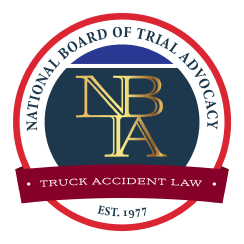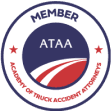Arizona Truck Accident Laws & Regulations
Commercial truck drivers and the companies that employ them provide a vital service to us all. Americans rely on trucking services to keep store shelves stocked and the economy running. With this responsibility comes certain expectations and responsibilities, many of which are outlined in state and federal trucking regulations. When truck drivers fail to follow the letter and spirit of the law, devastating truck accidents can occur.
If you have recently been injured in a crash involving a large commercial truck, read on to learn about the trucking laws and regulations that apply to Arizona truck accident cases. Contact an Arizona truck accident lawyer at Swenson & Shelley today for a free initial consultation to learn more about your rights as an accident victim and the opportunities for legal recourse available to you in the wake of a truck crash.
Visit our Truck Accident Lawyers in Phoenix, AZ
Arizona Trucking Speed Limits
When drivers of large commercial trucks exceed posted speed limits or drive too fast for conditions, they can cause devastating high-speed wrecks resulting in severe consequences. To discourage speeding and reduce the number of speeding truck accidents that occur in Arizona, state legislators have set a statewide maximum speed limit for commercial drivers.
Under §28-709 of the Arizona Revised Statutes (ARS), drivers of large vehicles and vehicles with trailers may not exceed 65 miles per hour on roadways. This regulation governs the speeds of trucks and tractor-trailer combinations with gross weights of 26,000 pounds or more. Unfortunately, many Arizona truck drivers ignore or intentionally break the law and exceed the posted speed limit and risk potentially deadly consequences as a result.
Arizona Trucking Weight Limits
Beyond a certain point, there’s no safe way to transport masses of heavy cargo on public roads. When trucks are overloaded, drivers are more likely to experience a loss of traction and dangerous shifts in their truck’s center of gravity. These conditions can contribute to loss of driver control, jackknifing, and rollover accidents.
To decrease the risk of overloaded truck accidents, Arizona imposes specific weight limits on commercial trucks under A.R.S. §28-1100:
- The maximum weight on any one axle of a vehicle cannot exceed 20,000 pounds, including enforcement tolerances.
- The maximum weight on a tandem vehicle axle cannot exceed 34,000 pounds, including enforcement tolerances.
- The maximum weight of any vehicle combination of five or more axles cannot exceed 80,000 pounds, including enforcement tolerances.
Under A.R.S. § 28-1103, drivers may apply for special permits for oversize and overweight loads only when:
- The overall length of the cargo-carrying segment of a tractor-trailer or combination of vehicles is no more than 95 feet.
- The maximum weight of each axle of the tractor-trailer or combination vehicle does not exceed the limits specified in § 28-1100.
- The overall gross weight of the tractor-trailer or combination vehicle is no more than 129,000 pounds.
- The vehicle is traveling no more than 20 miles outside of Arizona state borders and only to an adjacent state that allows such oversize or overweight loads.
Arizona CDL Requirements
There are different types of commercial driver’s licenses (CDLs) that correspond with different sizes of commercial vehicles. There are also special CDL designations that drivers can obtain to transport certain types of hazardous cargo.
To obtain a CDL in the state of Arizona, drivers must meet several state and federal requirements, including:
- Age requirements – To drive a commercial vehicle across state lines, you must prove that you are at least 21 years old. To operate as an intrastate commercial driver, you must be at least 18 years old.
- Identification requirements – Under Arizona state law, you must present two forms of identification for a standard driver’s license, which you must obtain before getting a CDL. If you do not have a photo ID, you must provide three qualifying forms of identification.
- Documentation requirements – Along with your completed CDL application, you must submit documentation, such as proof of your authorized presence in the U.S., proof of Arizona residence, and Social Security papers.
- Background checks – You are required to pass a background check to receive a CDL. You may be temporarily or permanently barred from obtaining a CDL if a background check reveals certain offenses on your record.
- Testing requirements – You must pass a knowledge test to obtain a commercial learner’s permit (CLP) before you can get your CDL. Then, you must pass a practical driving skills test while you have your CLP before you’ll qualify for a CDL.
- Medical exam requirements – Arizona requires commercial drivers to obtain a medical exam certificate and keep it on file with the state DMV. CDL holders must provide proof of a new physical every two years to keep their licenses.
Arizona Truck Inspection Requirements
Federal law requires annual inspections for all commercial vehicles carrying hazardous materials or weighing 10,001 pounds or more. This inspection requirement applies to each portion of a combination vehicle, such as both the tractor and trailer in a tractor-trailer combination.
Appendix A of §396 of the Code of Federal Regulations (CFR) specifies the following components that carriers must submit for inspection once every 12 months:
- Brake systems
- Coupling devices
- Exhaust systems
- Fuel systems
- Lighting devices
- Securement devices
- Steering mechanisms
- Suspensions
- Vehicle frames
- Tires, wheels, and rims
- Windshield glazing and wipers
- Motorcoach seats
- Rear impact guards
In addition to these annual federal inspection requirements, C.F.R. § 396.11 mandates that motor carriers require their drivers to inspect and report on the following components each day before operating their vehicles:
- Service brakes
- Trailer brake connections
- Parking brakes
- Steering mechanisms
- Lighting devices and reflectors
- Tires, wheels, and rims
- Horns
- Windshield wipers
- Rearview mirrors
- Coupling devices
- Emergency equipment
Understanding Federal Trucking Regulations
 In addition to the many Arizona laws that apply to commercial truck drivers, there are also plenty of federal trucking regulations that carriers and drivers must adhere to as well. Some essential rules include hours of service (HOS) regulations, which help to enforce healthy driver rest habits and reduce drowsy driving truck accident rates.
In addition to the many Arizona laws that apply to commercial truck drivers, there are also plenty of federal trucking regulations that carriers and drivers must adhere to as well. Some essential rules include hours of service (HOS) regulations, which help to enforce healthy driver rest habits and reduce drowsy driving truck accident rates.
Federal HOS regulations include:
- The 14-hour “driving window” – Commercial drivers are permitted to operate for up to 14 consecutive hours on any given day. During this 14-hour period, they may drive for up to 11 hours following at least 10 consecutive hours of off-duty time. Although the 14-hour window is understood as a daily time limit, a 14-hour day is not restricted to any specific 24-hour period.
- The 11-hour drive time limit – Commercial operators are prohibited from driving for more than 11 hours total within any consecutive 14 hours. When drivers have driven a total of 11 hours, they must take at least 10 hours of off-duty time until the 14-hour driving window resets. Notably, either the 14-hour driving window or the 11-hour drive time limit may be extended by up to two hours if drivers encounter adverse driving conditions that make it unsafe to stop.
- The 30-minute break requirement – Commercial drivers are required to take 30-minute off-duty rest breaks any time they drive more than eight consecutive hours following their last off-duty period. Any 30 minutes of mealtime, sleeper-berth time, or other off-duty time counts toward a required break. And importantly, these half-hour rest periods count toward the daily 14-hour driving window time limit.
- The 60/70-hour per week limit – This regulation prohibits commercial drivers from working more than 60 hours in a seven-day workweek or 70 hours in an eight-day workweek. Drivers may “restart” their seven- or eight-day workweeks and “reset” their weekly work hours back to zero by taking at least 34 consecutive hours of off-duty time. Drivers can perform other work-related duties during their 34 hours of off-duty time, such as administrative tasks or cargo loading, as long as they do not operate a commercial vehicle on public roads.
Another crucial federal regulation for commercial drivers is the Federal Motor Carrier Safety Administration’s (FMCSA’s) blood alcohol concentration (BAC) standards. The FMCSA has established a BAC limit of 0.04 percent for commercial drivers, which is half the legal limit for non-commercial drivers. Under C.R.F. § 392.5, commercial vehicle drivers are also entirely prohibited from using or being under the influence of alcohol within four hours before they begin operating their vehicles.
When commercial drivers ignore federal alcohol restrictions and BAC limits, they can be responsible for deadly drunk driving truck accidents. For this reason, commercial operators who drive under the influence can experience grave sanctions, which can severely limit their future employment opportunities.
CDL drivers are required to submit to a variety of on-the-job alcohol and controlled substance tests, including:
- Pre-employment drug and alcohol screening tests
- Post-accident drug and alcohol tests, which are required when truck accidents result in loss of life or drivers receive citations for accidents resulting in bodily injury or property damage
- Random alcohol tests for 10 percent of each trucking company’s drivers and random drug tests for 50 percent of a company’s drivers
- “Reasonable suspicion” tests, which are required for drivers who appear to be under the influence while on the job
- Return-to-duty tests and follow-up tests, which may be required for drivers who test positive for drugs or alcohol, refuse required tests, or violate other federal alcohol and drug policies
Hurt in a Truck Accident? Contact Our Attorneys Today
Truck accident victims deserve the relentless pursuit of justice the attorneys of Swenson & Shelley can provide them. If you have recently been hurt due to an accident involving a large commercial truck, contact us today to discuss the details of your truck accident case. During your free, no-obligation case review appointment, we’ll provide you with an objective analysis of your rights and options so that you can make informed decisions about your legal situation and process. We look forward to speaking with you.





















